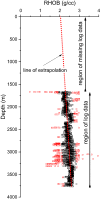Development of one dimensional geomechanical model for a tight gas reservoir
- PMID: 34728692
- PMCID: PMC8563761
- DOI: 10.1038/s41598-021-00860-z
Development of one dimensional geomechanical model for a tight gas reservoir
Abstract
Estimating rock-mechanical, petrophysical properties and pre-production stress state is essential for effective reservoir planning, development, and optimal exploitation. This paper attempts to construct a comprehensive one-dimensional mechanical earth model (1D MEM) of the Mandapeta gas reservoir of Krishna Godavari (KG) basin, India. The methodology comprises a detailed stepwise process from processing and analysis of raw log data, calibration of log-derived dynamic properties with static ones using regression models developed from tested core samples, and final rock mechanical property estimation. Pore pressure profiles have been estimated and calibrated with the Repeat formation tester (RFT) data for every thirty-five wells. Overburden and horizontal stresses have also been evaluated and calibrated using data from the Leak-off Tests (LOT) or Extended Leak-off Tests (XLOT). A menu-driven program is developed using PYTHON code for visualization and on-time revision of 1D MEM. The resulting comprehensive 1D MEM predicts and establishes the rock-mechanical properties, pore pressure, and in-situ stress values of the basin. Besides its use in planning future wells, development of the field, and yielding insight into the various well challenges, it can also be used to develop a 3D MEM of the reservoir.
© 2021. The Author(s).
Conflict of interest statement
The authors declare no competing interests.
Figures













References
-
- Plumb, R., Edwards, S. Pidcock, G. Lee, D. and Stacey, B. The mechanical earth model concept and its application to high risk well construction projects. IADC/SPE Drilling conference, New Orieans, Louisiana. 23–25 Feb, IADC/SPE 59218, 13 (2000).
-
- Guerra C, Fischer K, Henk A. Stress prediction using 1D and 3D geomechanical models of a tight gas reservoir—A case study from the Lower Magdalena Valley Basin, Colombia. Geomech. Energy Environ. 2019;19:100–113. doi: 10.1016/j.gete.2019.01.002. - DOI
-
- Ranjbar A, Hassani H, Shahriar K. 3D geomechanical modelling and estimating the compaction and subsidence of Fahlian reservoir formation. Arab. J. Geosci. 2017;10:116. doi: 10.1007/s12517-017-2906-3. - DOI
-
- Ali AHA, Brown T, Delgado R, Lee D, Plumb D, Smirov N, Marsden R, Prado-Velarde E, Ramsey L, Spooner D. Watchtbging rocks change-mechanical earth modelling. Oilfield Rev. 2003;15(1):22–39.
-
- Afsari, M., Ghafoori. M., Roostaeian, M., Haghshenas, A., Ataei, A. & Masoudi, R. Mechanical earth model: An effective tool for borehole stability analysis and managed pressure drilling (case study). SPE middle east oil and gas show and conference, 15–18 March, Manama, Bahrain, Soc Pet. Engg.SPE-118780-MS (2009).
LinkOut - more resources
Full Text Sources
Research Materials

